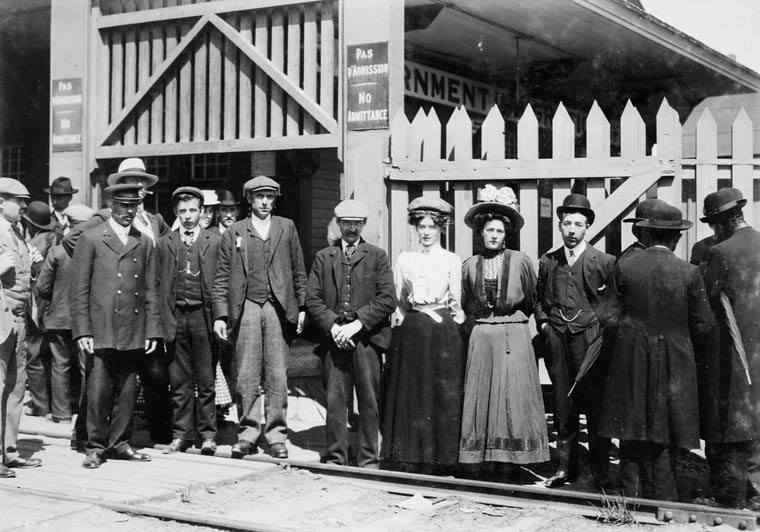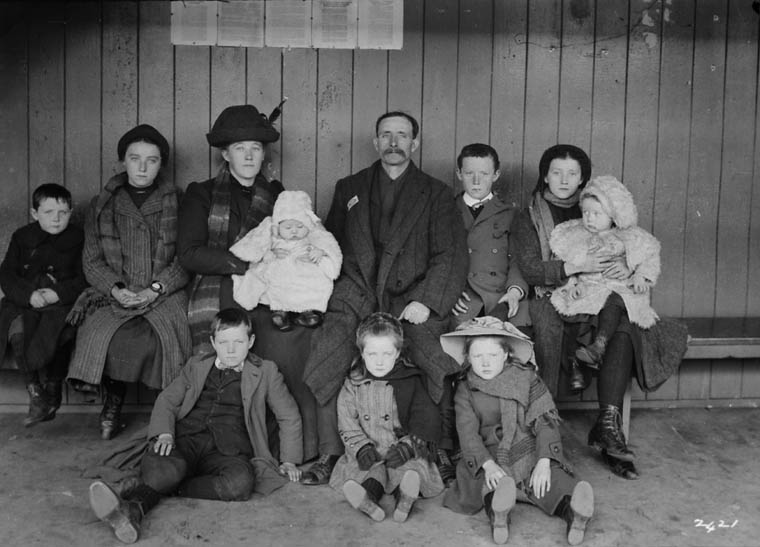During the early-twentieth century, emigration from Britain reached unprecedented levels, with approximately 3.15 million people leaving between 1903 and 1913. The most popular destination during these years was Canada, drawing almost half of Britain’s emigrants. What impact – economic, social and cultural – did these migrants have on Canada? This is the primary question that this project is endeavouring to answer. English emigrants have been chosen as the particular focus because they dominated the flow of emigrants from the British Isles and constituted a distinct ethnic group in Canada.
 |
A Group of English Immigrants in Quebec in 1908 (John Woodruff /Library and Archives Canada / C-014658)
|
Methodology
The project consists of two parts. Firstly, a sample of passenger lists for the years 1905, 1907, 1910 and 1912 is being transcribed. These passenger lists will provide information concerning the characteristics of the English immigrants who settled in Canada during these years, including their age, gender, marital status, occupations and geographical origins. This data is being linked as much as possible to that in the 1911 Canadian census. This will provide further information regarding the immigrants recorded in the passenger lists – where they actually settled in Canada, the occupations they eventually took up, and the wages they subsequently earned. Thus, a detailed profile of English settlement in Canada during the early-twentieth century will be established, showing who settled where and how they generally fared.
 | ||||||
|
The second – and core – part of this project is building and elaborating on these findings. It consists of case studies on three contrasting cities where English immigrants settled in large numbers – Toronto, Winnipeg and Regina. Data from the 1911 Canadian census is being analysed: the 5% sample which was prepared by the Canadian Century Research Infrastructure project is providing a valuable overview, while 20% samples of a selection of neighbourhoods in these cities are being prepared, which will allow for more in-depth analysis. The English immigrants in both of these samples are also going to be linked to their corresponding entries in Canadian and American passenger lists. This census and passenger list data will not only provide a detailed profile of the English immigrants who lived in these cities – providing information regarding gender, age, household composition, occupations, living standards, chain migration, and so on – but will also facilitate comparison with their non-English neighbours. Finally, the economic, social and cultural impact of English immigrants on these three cities, as well as their adjustment and accommodation to Canadian society, is also be researched using a wide range of archival materials, including local newspapers, the records of English immigrant societies, immigrant letters, and business and local government records.
 |
Immigrants en route to Canada aboard S.S. Empress of Britain, c. 1911 (JohnWoodruff/Library and Archives Canada/C-0015020)
|
Main Research Questions
This project is especially keen to assess the impact that English emigrants had on Canada during the early-twentieth century.
In particular, the role that English immigrants played in Canada’s phenomenal economic growth and development between 1896 and 1914 will be examined. While it has been argued by a handful of economic historians that immigration itself likely played an important role in this so-called ‘Wheat Boom’, much more research needs to be done to determine the exact nature of the relationship between immigration and economic growth during this period. This project is looking in particular at the human capital which English emigrants brought to Canada and how this was subsequently exploited.
 |
A Group of English Immigrants in Quebec in 1911 (William JamesTopley/Library and Archives Canada/PA-010399)
|
The impact of English immigrants on Canadian culture and identity during this period is also being explored. Despite their similarities to the dominant population in Canada, English immigrants were often greeted with a fair amount of hostility. This little-researched issue poses interesting questions in terms of Canadian identity during this period, as most English-speaking Canadians proudly identified themselves as being ‘British’, but expected English immigrants to become ‘Canadian’ and were often offended when they resisted. Thus, this project is investigating the integration of English immigrants into Canadian society. It is also examining how this large influx of English immigrants may have shaped the sense of Canada as being a British country, and the effect this may have had on the development of Canadian nationalism and identity during this period.